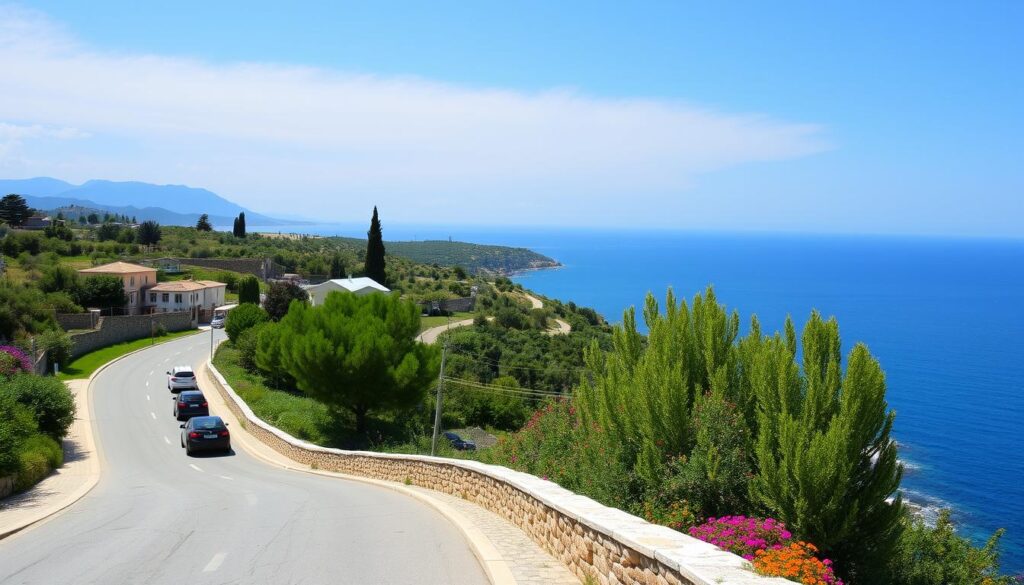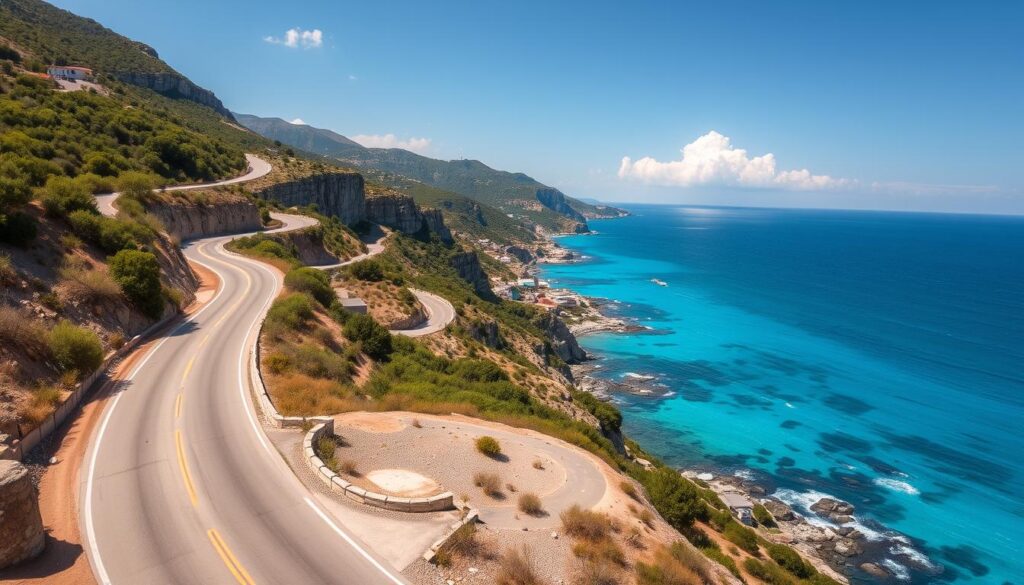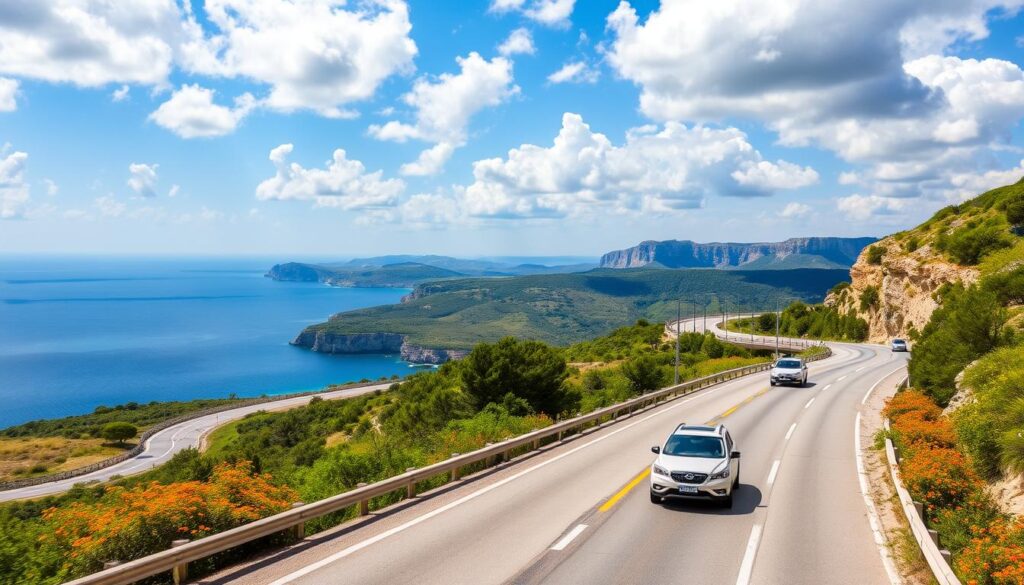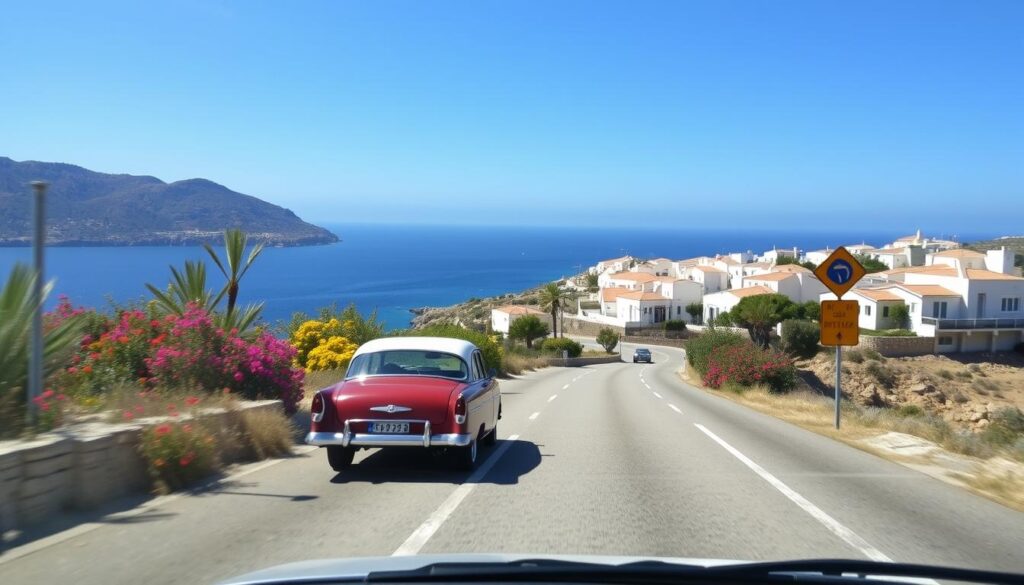Driving in Cyprus can be a rewarding experience, providing access to beautiful landscapes and fascinating sites throughout this Mediterranean island. With a population of approximately one million residents, primarily Greek Cypriots and Turkish Cypriots, Cyprus boasts over 801,000 registered vehicles, including about 550,000 passenger cars1. Car ownership is prevalent, as 85% of the population relies on personal vehicles for transportation, making it clear that public transport is still underdeveloped1. Familiarizing yourself with the unique aspects of Cyprus traffic is crucial for enhancing your driving experience and ensuring your safety on the road.
To learn more about important driving facts and tips, check out this insightful article on Cyprus Traffic. Understanding traffic laws, driving regulations, and the essential rules for navigating the roads will empower you to drive confidently and responsibly in Cyprus.
Key Takeaways
- The majority of Cypriots prefer driving due to limited public transportation.
- Key traffic laws include speed limits, seat belt usage, and rules for roundabouts.
- Alcohol limits for drivers are set at 0.05%, lower than in some other countries.
- Fines for traffic violations can be severe, making adherence to rules essential.
- Car rentals typically require a minimum age of 21 and a few years of driving experience.
- Emergency services can be reached in Cyprus by dialing 112.
Unlock Investment Opportunities Abroad!
Overview of Driving in Cyprus
Driving in Cyprus offers a unique experience for both residents and visitors. With a population exceeding one million, there are over 801,000 registered vehicles on the island. Approximately 68% of these vehicles are passenger cars, highlighting the importance of personal transportation in daily life. Urban areas boast speed limits of 50 km/h, whereas open roads allow for 80 km/h and motorways reach up to 100 km/h, making understanding local regulations essential for effective Cyprus commuting2.
Population and Vehicle Registration Statistics
The significant number of vehicles relates to the insufficient availability of public transportation options in Cyprus. The public transit system mainly consists of city and intercity buses, which often operate on limited schedules, creating inconvenience for commuters2. The warm climate further reinforces the preference for driving, as many choose personal cars equipped with air conditioning, enhancing comfort during travel2.
Why People Prefer Driving Over Public Transportation
Many residents and tourists prefer to rely on driving in Cyprus due to the lack of convenience offered by public transportation, prompting a higher dependency on personal vehicles for commuting3. Additionally, the scenic drives make for a pleasurable way to explore the beautiful landscapes of the island. Visitors seeking car rentals should prepare adequately, considering that rental agencies typically require drivers to be at least 21 years old and may impose extra fees for those under 253.

In conclusion, an understanding of Cyprus transportation and the driving landscape significantly enhances one’s experience while navigating this Mediterranean gem. For practical tips and essential information regarding driving regulations, refer to comprehensive guides on Driving in Cyprus2.
Understanding Cyprus Traffic Laws
Understanding the traffic laws in Cyprus is essential for anyone driving on the island. Cyprus Traffic Laws are designed to improve road safety and ensure that drivers comply with regulations for various scenarios. The minimum driving age is 18 years, and all drivers must possess a valid driver’s license. Additionally, it is crucial to ensure that all occupants, including children under 12, are secured in appropriate seats.
Key Driving Regulations and Requirements
The speed limits enforced in Cyprus help maintain Cyprus Road Safety. In residential areas, the speed limit is 50 km/h unless stated otherwise. Urban roads typically have a limit of 80 km/h, while on motorways, the maximum speed is set at 100 km/h, with a minimum of 65 km/h. For specific zones like school zones or roadworks, a speed limit of 30 km/h is strictly upheld. Compliance with these speed limits is essential for avoiding penalties and enhancing safety on the roads42.
Seatbelt usage is mandatory for all passengers, emphasizing the importance of wearing seatbelts at all times. Children under the age of five must be secured in an appropriate child seat when traveling. Using a mobile phone while driving is prohibited unless it’s through hands-free devices. Victims of road traffic incidents often bear the result of irresponsible behavior, such as smoking while children are present in the vehicle4.
Alcohol Limits and Penalties
Driving under the influence of alcohol is strictly regulated in Cyprus. The legal blood alcohol limit is 0.049%, with serious penalties for those exceeding it, as the threshold for action is set at 0.05% or higher. Penalties may include heavy fines and points deducted from driving licenses. Familiarizing oneself with these laws helps avoid legal troubles and ensures a smoother driving experience.
Awareness of these stringent Cyprus Traffic Laws equates to safer roads and fewer accidents. Full compliance is not only a legal obligation but a responsible step toward better Cyprus Road Safety overall. For further details on driving regulations, refer to this traffic guide that outlines comprehensive information42.
Cyprus Traffic: Navigating Road Conditions
Driving in Cyprus presents distinctive challenges, especially due to its prevalent road features and varying speed limits. Understanding these aspects is crucial for ensuring a safe driving experience across the island.
Common Road Features and Driving Challenges
Cyprus road conditions can be complex, particularly in rural or hilly areas where the roads can be narrow and winding. Drivers should be aware of common features such as roundabouts, which may lack ample signage; reliance on road markings is essential for safe navigation. Utilizing navigation apps like Waze can significantly enhance a driver’s experience by providing updates on traffic conditions and warning about possible hazards, including road changes ahead and locations of traffic cameras. By leveraging the app’s features, drivers can improve road safety and make informed decisions to adapt to the ever-changing landscape of Cyprus traffic.
Speed Limits on Different Types of Roads
In Cyprus, speed limits are categorized based on road type. Urban areas generally enforce speed limits of 50 km/h, while roads outside city limits allow for speeds of 80 km/h. When driving on motorways and highways, the maximum limit increases to 100 km/h2. Familiarizing oneself with these limits is vital to ensuring compliance with traffic regulations, which contributes to overall road safety.

These speed restrictions are in place as part of Cyprus’ broader commitment to road safety, as evidenced by a notable decrease in road traffic accidents recorded5. By adhering to the prescribed limits, drivers not only protect themselves but contribute to the safety of all road users.
Safe driving practices such as maintaining a safe distance from the vehicle in front, respecting traffic signs, and steering smoothly will aid in navigating the diverse Cyprus road conditions effectively6.
Unlock Investment Opportunities Abroad!
Motorway and Highway Insights
Driving on Cyprus motorways offers a unique experience due to their specific regulations and layout. Cyprus Highways connect major cities like Nicosia, Limassol, and Larnaca, providing essential routes for both locals and tourists. While the motorway network is limited, it serves as a crucial backbone for travel. The speed limit on these highways is capped at 100 km/h, and the left lane is strictly for overtaking, ensuring smooth traffic flow7. It is critical to remember that stops or parking on the highway are not allowed, enforcing a disciplined approach towards Cyprus Traffic.
Driving on Cyprus Motorways
Traveling on Cyprus Highways requires adherence to specific driving customs. The need for caution increases, especially with the presence of advanced speed monitoring systems. These systems play a key role in maintaining safety along the routes. Observations of average speeds suggest potential adjustments in driving habits to enhance overall safety8.
Key Highways Connecting Major Cities
Several key highways are pivotal in linking Cyprus’ major urban areas. For instance, the highway connecting Nicosia to Limassol features some of the highest average speeds recorded on the island, reaching up to 107.11 km/h8. Understanding the characteristics of these highways can significantly improve travel efficiency and reduce time spent in transit. Traffic patterns indicate peak times that drivers should be aware of, as congestion can greatly affect journey durations9.

Essential Driving Tips for Cyprus
Driving in Cyprus can be an exciting adventure, but certain adjustments are necessary for a safe and pleasant experience. Understanding the unique driving conditions and being adequately prepared is crucial for all travelers. Here are some essential Cyprus Driving Tips for navigating the island.
Adjusting to Left-Side Driving
One of the first challenges for visitors is adjusting to driving on the left side of the road, which can be quite disorienting for those used to right-side driving. Remember to remain vigilant, especially at roundabouts, as the flow of traffic will be different. Embrace the experience by exploring scenic Cyprus Travel Routes while staying mindful of local driving behaviors.
Recommended Documents and Preparation for Travelers
Before setting off, ensure you have all necessary documents, such as a valid driver’s license and a motor insurance certificate. It is advisable to carry the following items:
- Warning triangle
- Spare bulbs
- First-aid kit
These items can be invaluable should an unexpected situation arise. Drivers should be aware of local traffic regulations. For instance, maximum speeds on motorways are capped at 100 km/h, while built-up areas typically allow 50 km/h10. Also, remember that during peak traffic times, congestion can occur between 07.30 – 08.00 and 17.00 – 19.00, so plan travel times accordingly10.

Lastly, the legal blood alcohol limit in Cyprus is 0.22 g/100ml. Ensure adherence to this regulation to avoid heavy fines and ensure everyone’s safety11. Wild animals like mouflons may cross rural roads unexpectedly, particularly in hilly areas, so driving cautiously is essential11.
| Driving Tips | Details |
|---|---|
| Driving Side | Left-side driving |
| Required Documents | Driver’s license and motor insurance |
| Essential Items | Warning triangle, spare bulbs, first-aid kit |
| Speed Limits | 100 km/h on motorways, 50 km/h in towns |
| Peak Traffic Times | 07.30 – 08.00, 17.00 – 19.00 |
Conclusion
Navigating Cyprus Traffic requires a nuanced understanding of local driving culture, road conditions, and the nuances of traffic laws. With a car ownership rate of over 629 automobiles per 1,000 people, it’s evident that many prefer the convenience of driving over public transportation, which accounts for only 3% of journeys in Greater Nicosia12. However, the widespread disregard for traffic laws creates a challenging environment, as behaviors such as running red lights and using mobile phones while driving are prevalent13.
Moreover, lenient penalties and resource constraints within law enforcement further exacerbate the issue, leading to a perception of impunity13. Enhancing the overall driving experience involves not only adhering to established regulations but also fostering a culture of safety and responsibility. Efforts such as public awareness campaigns and improved infrastructure are crucial in reshaping the traffic environment in Cyprus for both residents and visitors alike13.
In summary, understanding the complexities of Cyprus Driving is essential for anyone wishing to navigate the roads safely. By respecting traffic laws and being aware of the local driving behaviors, you can make a meaningful contribution to safer roads in this beautiful Mediterranean destination.
Unlock Investment Opportunities Abroad!
FAQ
What is the driving age in Cyprus?
The minimum driving age in Cyprus is 18 years old, and all drivers must hold a valid license.
What should I know about Cyprus traffic laws?
It’s important to understand key regulations such as child seat requirements and the drink-driving limit of 0.05%. Violating these laws can result in steep fines and penalties.
Are there any specific road conditions to be aware of in Cyprus?
Cyprus has narrow, winding roads, particularly in hilly areas. Drivers should familiarize themselves with common road features and navigate carefully, especially in roundabouts.
What are the speed limits in Cyprus?
Urban speed limits in cities cap at 50 km/h, while highway speed limits range from 65 km/h to 100 km/h. Always adhere to these limits for road safety.
How do I navigate the motorway system in Cyprus?
The motorway network in Cyprus connects major cities like Nicosia, Limassol, and Larnaca, with a maximum speed limit of 100 km/h. Note that the left lane is for overtaking only.
What preparations should I make before driving in Cyprus?
Ensure you carry essential documents, such as a valid driver’s license and motor insurance certificate. It’s also advisable to have items like a warning triangle, spare bulbs, and a first-aid kit in your vehicle.
How does the driving culture differ in Cyprus compared to other countries?
Drivers in Cyprus drive on the left side of the road, which may be disorienting for visitors from countries that drive on the right. Familiarize yourself with local driving etiquette for a smoother experience.
Is public transportation a viable alternative to driving in Cyprus?
Public transportation in Cyprus is mainly limited to city and intercity buses, which do not run frequently. As a result, many residents and visitors prefer driving for convenience and comfort.
Source Links
- https://secrental.com/blog/driving-in-cyprus:-a-guide-to-road-rules-and-laws-when-renting-a-car
- https://www.sixt.co.uk/magazine/tips/driving-tips-in-cyprus/
- https://www.orbitcarhire.com/en/blog/driving-in-cyprus/
- https://www.trustcyprusinsurance.com/en/driving-in-cyprus-laws-regulations/
- https://www.articlesfactory.com/articles/travel/driving-in-cyprus.html
- https://cyprustravellerguide.com/using-waze-to-avoid-traffic-cameras/
- https://inrix.com/scorecard/
- https://www.xmap.ai/data-catalogs/cyprus-road-traffic-data
- https://www.rtinsights.com/smarter-motorways-with-real-time-analytics/
- https://www.europcar.com.cy/pages/driving-tips
- https://www.cyrentalcar.com/posts/driving-safety-tips-in-cyprus-your-roadmap-to-safe-travels
- https://en.wikipedia.org/wiki/Transport_in_Cyprus
- https://www.linkedin.com/pulse/why-citizens-republic-cyprus-often-disregard-traffic-laws-mike-flux-7xvvf

Comments